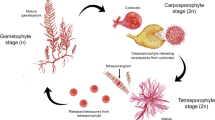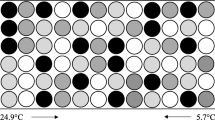Abstract
The kelp Laminaria digitata (Hudson) J.V. Lamouroux (Laminariales, Phaeophyceae) is currently cultivated on a small-scale in several north Atlantic countries, with much potential for expansion. The initial stages of kelp cultivation follow one of two methods: either maximising (gametophyte method) or minimising (direct method) the vegetative growth phase prior to gametogenesis. The gametophyte method is of increasing interest because of its utility in strain selection programmes. In spite of this, there are no studies of L. digitata gametophyte growth and reproductive capacity under commercially relevant conditions. Vegetative growth measured by length and biomass, and rate of gametogenesis, was examined in a series of experiments. A two-way fixed-effects model was used to examine the effects of both photoperiod (8:12; 12:12; 16:8, 24:0 L:D) and commonly used/commercially available growth media (f/2; Algoflash; Provasoli Enriched Seawater) on the aforementioned parameters. All media resulted in good performance of gametophytes under conditions favouring vegetative growth, while f/2 clearly resulted in better gametophyte performance and a faster rate of gametogenesis under conditions stimulating transition to fertility. Particularly, the extent of sporophyte production (% of gametophytes that produced sporophytes) at the end of the experiment showed clear differences between treatments in favour of f/2: f/2 = 30%; Algoflash = 9%; Provasoli Enriched Seawater = 2%. The effect of photoperiod was ambiguous, with evidence to suggest that the benefit of continuous illumination is less than expected. Confirmation of photoperiodic effect is necessary, using biomass as a measure of productivity and taking greater account of effects of genotypic variability.




Similar content being viewed by others
References
Arbona JF, Molla M (2006) Cultivation of brown seaweed Alaria esculenta. Aquaculture explained series. Bord Iascaigh Mhara, Dublin 50pp
Bartsch I, Wiencke C, Bischof K, Buchholz CM, Buck BH, Eggert A, Feuerpfeil P, Hanelt D, Jacobsen S, Karez R, Karsten U, Molis M, Roleda MY, Schubert H, Schumann R, Valentin K, Weinberger F, Wiese J (2008) The genus Laminaria sensu lato: recent insights and developments. Eur J Phycol 43:1–86
Choi HG, Kim YS, Lee SJ, Park EJ, Nam KW (2005) Effects of daylength, irradiance and settlement density on the growth and reproduction of Undaria pinnatifida gametophytes. J Appl Phycol 17:423–430
Cosson J, Gayral P (1979) Optimal conditions for growth and fertility of Laminaria digitata (Phaeophyceae) gametophytes. Proc Int Seaweed Symp 9:59–65
Davoult D, Engel CR, Arzel P, Knoch D, Laurans M (2011) Environmental factors and commercial harvesting: exploring possible links behind the decline of the kelp Laminaria digitata in Brittany, France. Cah Biol Mar 52:1–6
Edwards MD, Mooney-McAuley K, Gorman E, Champenois J (2016) Standard operating protocol manual for seaweed biomass cultivation and analysis. EnAlgae project report. http://www.enalgae.eu/public-deliverables.htm; Accessed on 29 Nov 2016
Gagne JA, Mann KH, Chapman ARO (1982) Seasonal patterns of growth and storage in Laminaria longicruris in relation to differing patterns of availability of nitrogen in the water. Mar Biol 69:91–101
Gao X, Agatsuma Y, Taniguchi K (2013) Effect of nitrate fertilization of gametophytes of the kelp Undaria pinnatifida on growth and maturation of the sporophytes cultivated in Matsushima Bay, northern Honshu, Japan. Aquacult Int 21:53–64
Gerard VA (1990) Ecotypic differentiation in the kelp Laminaria saccharina: phase-specific adaptation in a complex life cycle. Mar Biol 107:519–528
Gerard VA (1997) The role of nitrogen nutrition in high-temperature tolerance of the kelp, Laminaria saccharina (Chromophyta). J Phycol 33:800–810
Han T, Kain JM (1996) Effect of photon irradiance and photoperiod on young sporophytes of four species of the Laminariales. Eur J Phycol 31:233–240
Hoffmann AJ, Santelices B (1982) Effects of light intensity and nutrients on gametophytes and gametogenesis of Lessonia nigrescens Bory (Phaeophyta). J Exp Mar Biol Ecol 60:77–89
Hoffmann AJ, Avila M, Santelices B (1984) Interactions of nitrate and phosphate on the development of microscopic stages of Lessonia nigrescens Bory (Phaeophyta). J Exp Mar Biol Ecol 78:177–186
Holdt SL, Kraan S (2011) Bioactive compounds in seaweed: functional food applications and legislation. J Appl Phycol 23:543–597
Hsiao SI, Druehl LD (1973) Environmental control of gametogenesis in Laminaria saccharina. II. Correlation of nitrate and phosphate concentrations with gametogenesis and selected metabolites. Can J Bot 51:829–839
Iwai H, Fukushima M, Motomura T, Kato T, Kosugi C (2015) Effect of iron complexes with seawater extractable organic matter on oogenesis in gametophytes of a brown macroalga (Saccharina japonica). J Appl Phycol 27:1583–1591
Izquierdo JL, Pérez-Ruzafa IM, Gallardo T (2002) Effect of temperature and photon fluence rate on gametophytes and young sporophytes of Laminaria ochroleuca Pylaie. Helgol Mar Res 55:285–292
Kain JM (1979) A view of the genus Laminaria. Oceanogr Mar Biol 17:101–161
Kerrison PD, Stanley MS, Edwards MD, Black KD, Hughes AD (2015) The cultivation of European kelp for bioenergy: site and species selection. Biomass Bioenergy 80:229–242
Lewis RJ, Green MK, Afzal ME (2013) Effects of chelated iron on oogenesis and vegetative growth of kelp gametophytes (Phaeophycae). Phycol Res 61:46–51
Li D, Zhou Z, Liu H, Wu C (1999) A new method of Laminaria japonica strain selection and seedling culture by the use of vegetative gametophytes. Hydrobiologia 398/399:473–476
Lüning K (1972) Reproduction induced by blue light in female gametophytes of Laminaria saccharina. Planta 104:252–256
Lüning K (1980) Critical levels of light and temperature regulating the gametogenesis of three Laminaria species (Phaeophyceae). J Phycol 16:1–15
Lüning K, Dring MJ (1975) Reproduction, growth and photosynthesis of gametophytes of Laminaria saccharina grown in blue and red light. Mar Biol 29:195–200
Lüning K, Neushul M (1978) Light and temperature demands for growth and reproduction of laminarian gametophytes in southern and central California. Mar Biol 45:297–309
Mohring MB, Kendrick GA, Wernberg T, Rule MJ, Vanderklift MA (2013) Environmental influences on kelp performance across the reproductive period: an ecological trade-off between gametophyte survival and growth? PLoS One 8:e65310
Morelissen B, Dudley BD, Geange SW, Phillips NE (2013) Gametophyte reproduction and development of Undaria pinnatifida under varied nutrient and irradiance conditions. J Exp Mar Biol Ecol 448:197–206
Motomura T, Sakai Y (1984) Regulation of gametogenesis of Laminaria and Desmarestia (Phaeophyta) by iron and boron. Jap J Phycol 32:209–215
Nielsen MM, Kumar JP, Soler-Vila A, Johnson MP, Bruhn A (2016) Early stage growth responses of Saccharina latissima spores and gametophytes. Part 1: inclusion of different phosphorus regimes. J Appl Phycol 28:387–393
Shea R, Chopin T (2007) Effects of germanium dioxide, an inhibitor of diatom growth, on the microscopic laboratory cultivation stage of the kelp, Laminaria saccharina. J Appl Phycol 19:27–32
Tala F, Edding M, Vásquez J (2004) Aspects of the reproductive phenology of Lessonia trabeculata (Laminariales: Phaeophyceae) from three populations in northern Chile. N Z J Mar Freshw Res 38:255–266
Westermeier R, Patiño D, Piel MI, Maier I, Mueller D (2006) A new approach to kelp mariculture in Chile: production of free-floating sporophyte seedlings from gametophyte cultures of Lessonia trabeculata and Macrocystis pyrifera. Aquac Res 37:164–171
Wu C, Li D, Liu H, Peng G, Liu J (2004) Mass culture of Undaria gametophyte clones and their use in sporeling culture. Hydrobiologia 512:153–156
Xu Z, Dapeng L, Hanhua H, Tianwei T (2005) Growth promotion of vegetative gametophytes of Undaria pinnatifida by blue light. Biotechnol Lett 27:1467–1475
Xu B, Zhang QS, Qu SC, Cong YZ, Tang XX (2009) Introduction of a seedling production method using vegetative gametophytes to the commercial farming of Laminaria in China. J Appl Phycol 21:171–178
Zhang QS, Qu SC, Cong YZ, Luo SJ, Tang XX (2008) High throughput culture and gametogenesis induction of Laminaria japonica gametophyte clones. J Appl Phycol 20:205–211
Zhi C, Rorrer GL (1996) Photolithotrophic cultivation of Laminaria saccharina gametophyte cells in a bubble-column bioreactor. Enzym Microb Technol 18:291–299
Acknowledgements
This study was jointly funded by (1) SuperGen Biomass Biofuels and Energy Crops II under EPSRC grant EP/039995 through Leeds University and (2) The Seaweed Hatchery Project (PBA/SW/07/001 (01), carried out under the Sea Change Strategy with the support of the Marine Institute and the Marine Research Sub-programme of the National Development Plan, 2007–2013.
The authors would also like to acknowledge the help given by Colm Moriarty for the technical assistance in setting up the culture chambers and Jazmin Hernandez-Kantun and Jyotsna Mishra for their help with sample preparation and analysis.
Author information
Authors and Affiliations
Corresponding author
Rights and permissions
About this article
Cite this article
Ratcliff, J.J., Soler-Vila, A., Hanniffy, D. et al. Optimisation of kelp (Laminaria digitata) gametophyte growth and gametogenesis: effects of photoperiod and culture media. J Appl Phycol 29, 1957–1966 (2017). https://doi.org/10.1007/s10811-017-1070-1
Received:
Revised:
Accepted:
Published:
Issue Date:
DOI: https://doi.org/10.1007/s10811-017-1070-1




